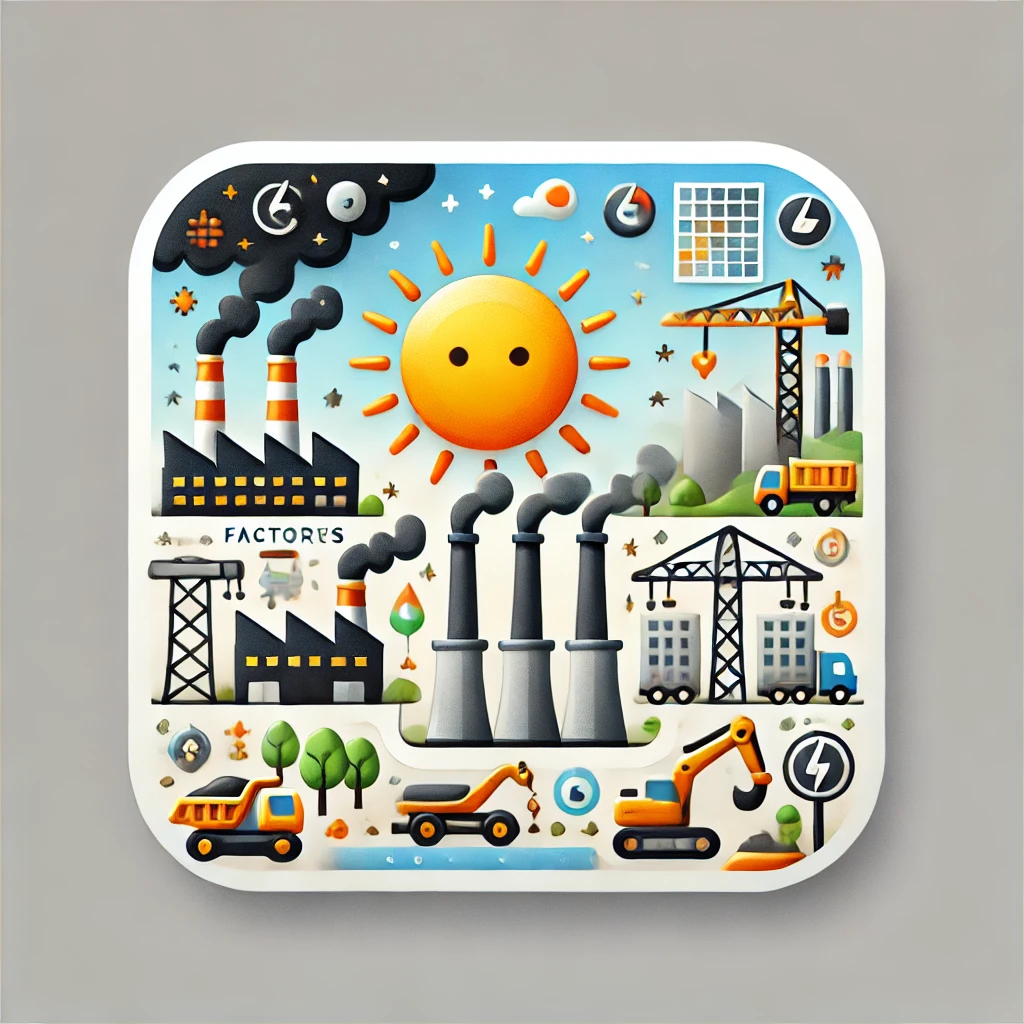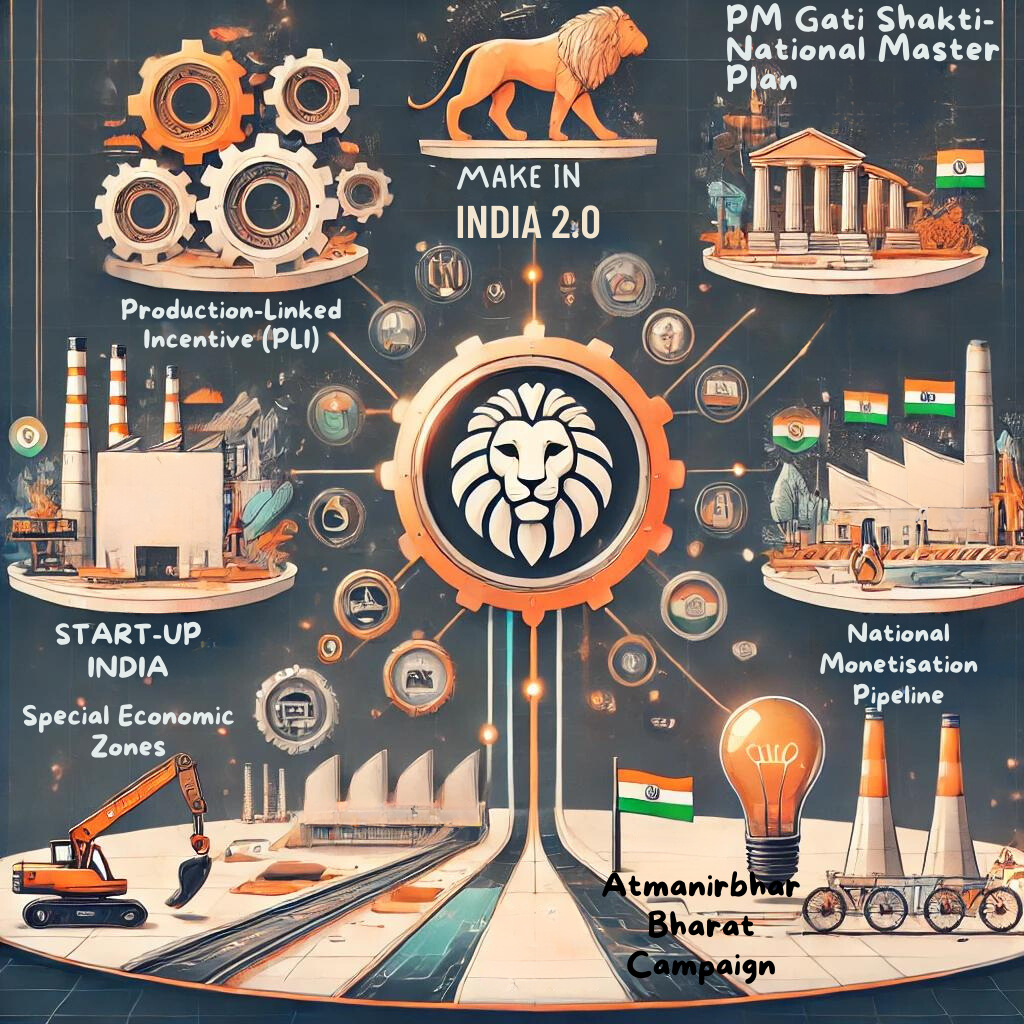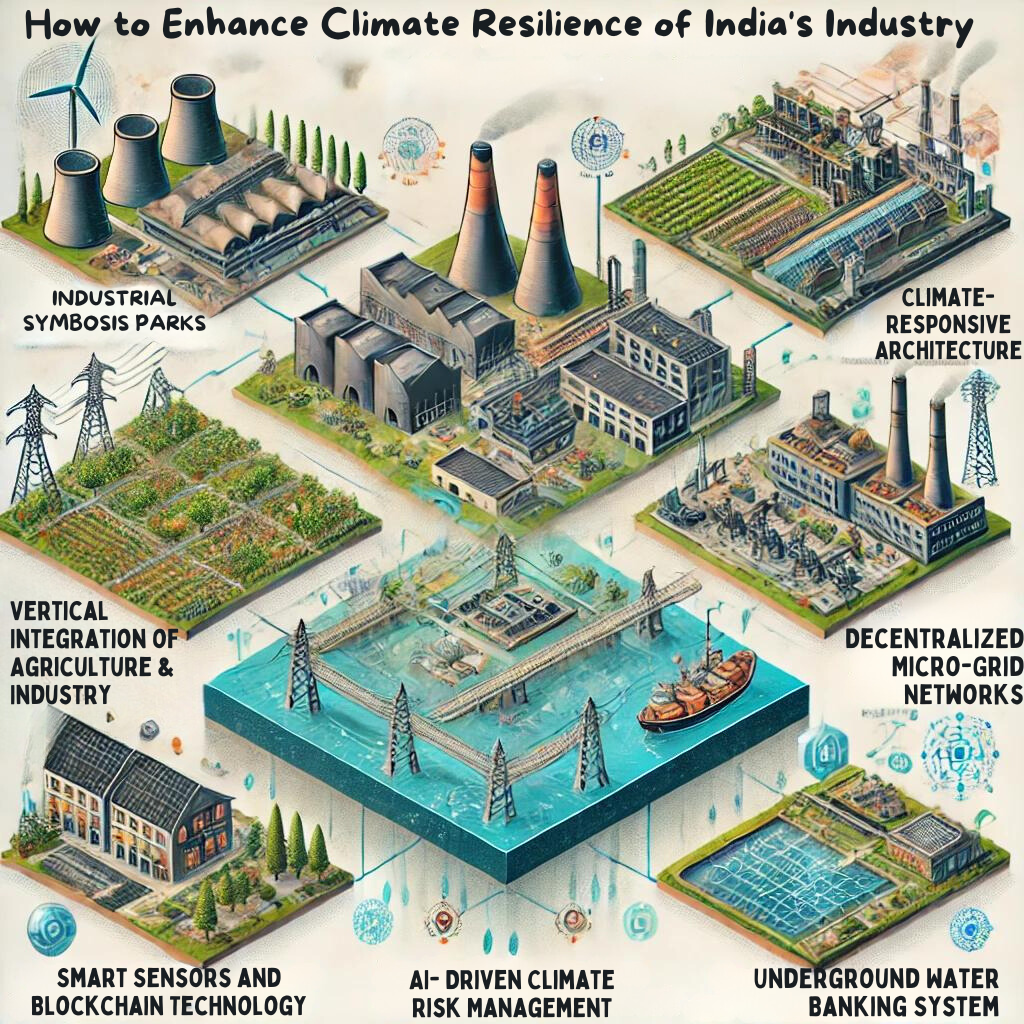India’s industrial sector faces significant challenges due to climate resilience. Recent data from May 2023 shows a slowdown in core sectors like crude oil, fertilizers, and cement, primarily because of a severe heatwave. Despite growth in coal and electricity production due to increased cooling needs, construction activities in northern India were badly affected.
To enhance climate resilience, the government can implement measures such as developing industrial symbiosis parks, promoting climate-responsive architecture, using AI-driven climate risk management, forming decentralized micro-grid networks, integrating agriculture with industry, and establishing underground water banking systems. These initiatives can help industries adapt to climate impacts, ensuring long-term sustainability and economic stability.
Origin of the Article
This editorial is based on “Mixed signals: On data and the key industrial sectors” published in The Hindu on 07/05/2024.
Relevancy for UPSC Students
Understanding the impact of climate change on key industrial sectors is vital for UPSC aspirants. It aligns with GS Paper 3 topics like Industrial Policy, Infrastructure, and Growth & Development. This knowledge helps in preparing for questions on economic and environmental issues, offering a comprehensive understanding of contemporary challenges and policy responses.

Why in News
The recent severe heatwave in May 2023 has caused a significant slowdown in India’s core industrial sectors, making it a critical topic for UPSC aspirants. The resilience of coal and electricity production amid this heatwave, contrasted with contractions in sectors like crude oil and cement, underscores the vulnerability of India’s industrial growth to climate change. This topic is relevant for both Prelims and Mains as it connects with previous UPSC questions on industrial growth, climate change impacts, and economic policies, fostering a deeper understanding of sustainable development challenges in India.
Sectors Driving India’s Industrial Growth
India’s industrial growth is powered by various dynamic sectors, each contributing uniquely to the nation’s economic landscape. Key sectors such as Information Technology (IT), renewable energy, e-commerce, food processing, aerospace and defense, pharmaceuticals, telecommunications, electric vehicles, textiles, and fintech are pivotal. These sectors not only drive employment and GDP but also reflect India’s technological and infrastructural advancements.
Information Technology (IT) and IT-enabled Services
The IT sector is a cornerstone of India’s economy, projected to reach USD 350 billion by FY 2026. Employing over 4.5 million people, it contributes 8% to the GDP. The rapid adoption of cloud services is notable, with the Indian Public Cloud Services market expected to hit USD 13.5 billion by 2026.
Renewable Energy
India ranks 4th globally in renewable power capacity, aiming for 500 GW by 2030. Projects like the Bhadla Solar Park, the world’s largest, exemplify India’s commitment to renewable energy. This sector is crucial for sustainable growth and energy security.
E-commerce and Digital Services
E-commerce in India is growing at a CAGR of 27%, expected to reach USD 163 billion by 2026. With over 820 million internet users, digital payments, particularly UPI, have surged. Companies like Flipkart and Amazon are expanding into Tier 2 and Tier 3 cities, driving sectoral growth.
Food Processing
India’s vast agricultural base supports a robust food processing industry. Rising incomes and urbanization fuel the demand for processed food. Companies like ITC, Britannia, and Nestle are expanding operations, capitalizing on the growing market for packaged food products.
Aerospace and Defense
India’s aerospace and defense sector aims for USD 25 billion in production by 2025. Self-reliance policies, like the ban on 101 defense imports, and indigenous projects like the Tejas Light Combat Aircraft and Agni-V missile highlight the sector’s growth and strategic importance.
Pharmaceuticals and Biotechnology
India is a global leader in generic medicines, supplying 20% of the world’s volume. The pharmaceutical sector is expected to reach USD 130 billion by 2030, while biotechnology could hit USD 150 billion by 2025, driven by over 5,000 biotech startups.
Telecommunications
India’s second-largest telecom industry globally had 1.091 billion subscribers as of April 2024. The ongoing 5G rollout is expected to contribute USD 450 billion to the economy by 2040, highlighting the sector’s pivotal role in digital connectivity.
Electric Vehicles (EVs)
India’s EV market is projected to reach USD 206 billion by 2030. Government policies like FAME II aim for 30% of private cars to be electric by 2030, supported by plans for 69,000 charging stations, reflecting a strong push towards sustainable transportation.
Textiles and Apparel
The textiles and apparel sector contributes 2.3% to GDP, 13% to industrial production, and 12% to exports. Initiatives like the Production Linked Incentive (PLI) scheme aim to boost manufacturing, particularly in man-made fiber apparel and technical textiles.
Fintech
India’s fintech market is projected to reach USD 150 billion by 2025, with over 6,636 startups. Digital payments lead the sector, supported by government initiatives like Jan Dhan Yojana, promoting financial inclusion and innovation.
Recent Government Initiatives for Growth of Industrial Sector in India
The Indian government has launched several initiatives to boost industrial growth, focusing on manufacturing, infrastructure, and innovation. These initiatives aim to create a conducive environment for industrial development and attract investment.

Production-Linked Incentive (PLI)
The PLI scheme provides financial incentives to boost manufacturing across various sectors. It aims to enhance domestic production and reduce dependence on imports, thereby strengthening the industrial base.
PM Gati Shakti- National Master Plan
This plan focuses on infrastructure development and improving logistics efficiency. Streamlining processes and reducing bottlenecks aims to accelerate industrial growth and connectivity across the country.
Start-up India
The Start-up India initiative promotes innovation and entrepreneurship. It provides funding, mentorship, and regulatory support to startups, fostering a vibrant ecosystem for new business ventures and industrial growth.
Make in India 2.0
Make in India 2.0 aims to boost manufacturing and attract foreign investment. It seeks to transform India into a global manufacturing hub by creating a favorable business environment and offering incentives.
Atmanirbhar Bharat Campaign
This campaign focuses on self-reliance and import substitution. It encourages domestic production, innovation, and sustainable practices, aiming to reduce dependence on foreign goods and strengthen the local industry.
Special Economic Zones
Special Economic Zones (SEZs) promote industrial growth by offering tax incentives and export-oriented policies. These zones attract investment and boost exports, contributing to economic development.
National Monetisation Pipeline
This initiative aims to unlock value from public assets through asset monetization. It focuses on leveraging public infrastructure for private investment, generating revenue, and improving industrial efficiency.
Major Threats of Climate Change to India’s Industrial Sector
Climate change poses significant threats to India’s industrial sector. Water scarcity, extreme weather events, rising temperatures, and supply chain disruptions are critical challenges that industries must address to ensure sustainable growth.
Water Scarcity and Stress
By 2050, 50% of India’s districts could face severe water scarcity, threatening water-intensive industries like textiles and power generation. NITI Aayog warns that this could result in a 6% GDP loss if unaddressed.
Extreme Weather Events
Increasing cyclones, floods, and heatwaves pose risks to industrial infrastructure. Cyclone Amphan in 2020 caused USD 14 billion in losses, highlighting the vulnerability of supply chains and production facilities.
Rising Temperatures
Higher temperatures reduce worker productivity and increase cooling costs. The United Nations projects a 5.8% loss in daily working hours by 2030, affecting industrial output and economic stability.
Supply Chain Disruptions
Climate change heightens supply chain vulnerabilities, disrupting transportation and raw material availability. The automobile sector, reliant on just-in-time manufacturing, is particularly at risk from such disruptions.
Regulatory and Market Pressures
Stricter climate regulations and market dynamics compel industries to adopt sustainable practices. Initiatives like the EU’s Carbon Border Adjustment Mechanism could impact India’s export-oriented sectors, necessitating compliance with global standards.
Shifting Disease Patterns and the Healthcare Industry
Climate change alters disease patterns, challenging India’s pharmaceutical and healthcare sectors. Rising temperatures expand the range of diseases like malaria and dengue, requiring new treatments and adaptive healthcare systems.
Climate-Induced Migration and Labor Market Disruptions
Climate change triggers internal migration, affecting labor markets. Rural industries may face labor shortages, while urban industries could struggle with population influxes, leading to social tensions and infrastructure strain.
Changing Atmospheric Chemistry and Industrial Processes
Changing CO2 levels impact industrial processes like cement curing and chemical synthesis. These changes necessitate significant R&D investments and process modifications to maintain efficiency and product quality.
Coastal Industrial Corridors at Risk
India’s coastal industrial corridors face threats from sea-level rise and cyclones. Cyclone Nisarga in 2020 forced the shutdown of the Jawaharlal Nehru Port Trust, disrupting nationwide supply chains and highlighting the need for resilient infrastructure.
PESTEL Analysis
| Political: The government’s response to climate impacts, such as the Production-Linked Incentive (PLI) and Atmanirbhar Bharat campaigns, showcases an initiative to strengthen the industrial sector. Policies promoting renewable energy and sustainable practices are crucial but need vigorous enforcement and expansion to accommodate climate adaptation. Economic: Economic effects are mixed; while sectors like IT and renewable energy continue to thrive, traditional sectors like cement and fertilizers are experiencing downturns due to operational disruptions from heat waves. The economic push towards digital and green sectors is evident, which might redefine India’s industrial priorities and investments. Social: Social impacts include workforce challenges due to rising temperatures, potentially reducing productivity, and escalating health risks. Additionally, internal migration due to environmental distress could affect urban industrial capacities and demand shifts in various sectors. Technological: Technological advancements in AI for climate risk management and the promotion of EVs and other green technologies reflect a progressive shift. These innovations could provide critical solutions to climate-related disruptions by enhancing predictive capabilities and reducing dependence on traditional energy sources. Environmental: Direct environmental challenges such as water scarcity, extreme weather, and changing disease patterns are pressing. These factors necessitate a transformative approach to how industries operate and manage resources, emphasizing sustainability and resilience against climate variability. Legal: Regulatory pressures will likely increase as global and national focus intensifies on climate action. Industries will need to adapt to stricter environmental regulations, which could involve significant restructuring of operations and increased compliance costs. |
Measures to Enhance Climate Resilience of India’s Industrial Sector
Strategic measures are essential to enhance the climate resilience of India’s industrial sector. These include developing industrial symbiosis parks, adopting climate-responsive architecture, leveraging AI for risk management, and promoting decentralized energy networks.
Industrial Symbiosis Parks
Industrial symbiosis parks facilitate collaboration among industries to utilize each other’s waste and byproducts. This approach reduces waste and emissions, creating a resilient ecosystem less reliant on external resources.
Climate-Responsive Architecture for Factories
Climate-adaptive buildings, including self-shading structures, green roofs, and underground factories, can mitigate climate impacts. These architectural adaptations help maintain stable temperatures and reduce energy consumption.
Artificial Intelligence-Driven Climate Risk Management
AI systems can manage climate risks by integrating real-time data and long-term projections. These systems optimize production schedules, supply chains, and adaptation measures, enhancing resilience.
Decentralized Micro-Grid Networks
Decentralized energy networks with renewable generation and storage capabilities enhance climate resilience. These microgrids enable energy sharing during disruptions, ensuring continuous industrial operations.
Vertical Integration of Agriculture and Industry
Combining vertical farming with food processing reduces transportation needs and increases resilience. Climate-controlled vertical farming ensures steady agricultural production, supporting related industries.
Underground Water Banking System
Underground aquifer recharge and storage facilities create water reserves for dry periods. This system ensures fair water distribution among industries, particularly in water-stressed regions, enhancing resilience.
Smart Sensors and Blockchain Technology
Smart sensors and blockchain can manage water credits and distribution among industries. These technologies ensure efficient water use and fair allocation, supporting sustainable industrial operations.

Conclusion
In navigating the complexities of climate change, India’s industrial sector faces both formidable challenges and unique opportunities. By adopting resilient strategies and innovative technologies, we can build a future-ready industrial base. For UPSC aspirants, understanding these dynamics is crucial, as it shapes not only economic policies but also sustainable development goals. Let’s envision and work towards a resilient, sustainable industrial future for India.
| UPSC Civil Services Examination, Previous Year Questions (PYQs) Mains Q. Discuss the impact of heatwaves on India’s agriculture and industrial sectors. What measures can be taken to mitigate these effects? (GS Paper III, 2021). Q. The Production Linked Incentive (PLI) scheme has been introduced to boost manufacturing in India. Critically examine its potential and challenges. (GS Paper III, 2021). |

